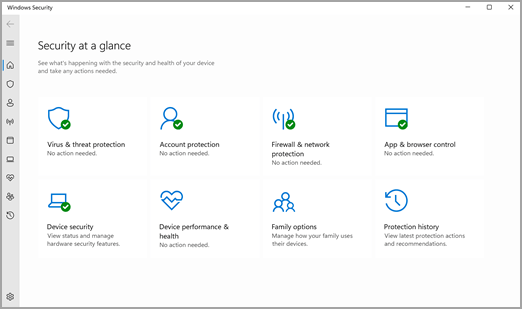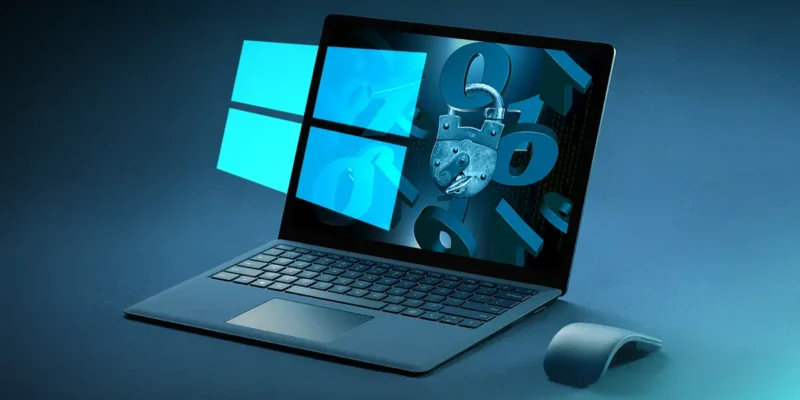How to stay protected with Windows Security
Windows 10 and 11 users can now relax as these two versions come with Windows Security by default which provides the latest antivirus protection. Windows Security will continually can for malware, viruses and security threats. In addition to this real-time protection, updates are downloaded automatically to help keep your device safe and protect it from threats.


Windows 10 or 11 in S mode
Some features will be a little different if you’re running Windows 10 or 11 in S mode. Because this mode is streamlined for tighter security, the Virus & threat protection area has fewer options. But don’t worry—the built-in security of this mode automatically prevents viruses and other threats from running on your device, and you’ll receive security updates automatically.
Important security info
- Windows Security is built-in to Windows and includes an antivirus program called Microsoft Defender Antivirus. (In early versions of Windows 10, Windows Security is called Windows Defender Security Center).
- If you have another antivirus app installed and turned on, Microsoft Defender Antivirus will turn off automatically. If you uninstall the other app, Microsoft Defender Antivirus will turn back on automatically.
- If you’re having problems receiving Windows Security updates, check out Fix Windows Update errors and the Windows Update FAQ.
- For info on how to uninstall an app, see Repair or remove an app in Windows.
- To change your user account to an admin account, see Create a local user or administrator account in Windows.
Understand and customize Windows Security features
Windows Security is your home to manage the tools that protect your device and your data:
Virus & threat protection – Monitor threats to your device, run scans, and get updates to help detect the latest threats. (Some of these options are unavailable if you’re running Windows 10 in S mode.)
Account protection – Access sign-in options and account settings, including Windows Hello and dynamic lock.
Firewall & network protection – Manage firewall settings and monitor what’s happening with your networks and internet connections.
App & browser control – Update settings for Microsoft Defender SmartScreen to help protect your device against potentially dangerous apps, files, sites, and downloads. You’ll have exploit protection and you can customize protection settings for your devices.
Device security – Review built-in security options to help protect your device from attacks by malicious software.
Device performance & health – View status info about your device’s performance health, and keep your device clean and up to date with the latest version of Windows.
Family options – Keep track of your kids’ online activity and the devices in your household.
To customize how your device is protected with these Windows Security features select Start > Settings > Update & Security > Windows Security or select the button below.
Open Windows Security settings
Status icons indicate your level of safety:
- Green means there aren’t any recommended actions right now
- Yellow means there is a safety recommendation for you.
- Red is a warning that something needs your immediate attention.
Run a malware scan manually
When you’re concerned about risks to a specific file or folder, you can right- click the file or folder in File Explorer, then select Scan with Microsoft Defender.
If you suspect there’s malware or a virus on your device, you should immediately run a quick scan. This is much faster than running a full scan on all your files and folders.
Run a quick scan in Windows Security
- Select Start > Settings > Update & Security > Windows Security and then Virus & threat protection.
Open Windows Security settings - Under Current threats, select Quick scan (or in early versions of Windows 10, under Threat history, select Scan now).
If the scan doesn’t find any issues, but you’re still concerned, you may want to
check your device more thoroughly.
Run an advanced scan in Windows Security
- Select Start > Settings > Update & Security > Windows Security and then Virus & threat protection.
- Under Current threats, select Scan options (or in early versions of Windows 10, under Threat history, select Run a new advanced scan).
- Select one of the scan options:
Full scan (check files and programs currently running on your device)
Custom scan (scan specific files or folders)
Microsoft Defender Offline scan (run this scan if your device has been, or could potentially be, infected by a virus or malware). Learn more about Microsoft Defender Offline - Select Scan now.
Schedule your own scan
Even though Windows Security is regularly scanning your device to keep it safe, you can also set when and how often the scans occur.
Schedule a scan
- Select the Start button, type schedule tasks in the Search box, and in the list of results, select Task Scheduler.
- In the left pane, select the arrow (>) next to Task Scheduler Library to expand it, do the same with Microsoft > Windows, and then scroll down and select the Windows Defender folder.
- In the top-center pane, select Windows Defender Scheduled Scan. (Point to the choices to see the full names.)
- In the Actions pane on the right, scroll down and then select Properties.
- In the window that opens, select the Triggers tab, and then select New.
- Set your preferred time and frequency, and then select OK.
- Review the schedule and select OK.
Turn Microsoft Defender Antivirus real-time protection on or off
Sometimes you may need to briefly stop running real-time protection. While real-time protection is off, files you open or download won’t be scanned for threats. However, real-time protection will soon turn on automatically again to protect your device.
Turn real-time protection off temporarily
- Select Start > Settings > Update & Security > Windows Security and then Virus & threat protection > Manage settings. (In early versions of Windows 10, select Virus & threat protection > Virus & threat protection
settings.) Open Windows Security settings - Switch the Real-time protection setting to Off and choose Yes to verify.
















